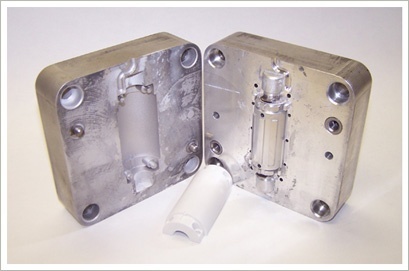Material Formulation
What is a Thermoset?

Thermoset plastics are polymers similar to, but generally stronger than, thermoplastics because of polymer cross-linking. Thermosets also have a higher resistance to heat. Cured thermoset resins may soften when heated, but will not melt or flow. Due to their inherent irreversibility, many thermosets cannot be recycled.
Filled or Reinforced Products
Products made from resins and modifiers such as pigments, plasticizers, or chopped fibers are known as filled or reinforced products. By contrast, unfilled resins, base polymers, and raw materials do not contain additives. Typically, raw materials are available as pellets, powders, granules, or liquids.
Fibers can be either chopped or wound, and commonly include glass, fiberglass, or cloth. Some products contain solid lubricant fillers such as graphite or molybdenum disulfide. Others contain aramid fibers, metal powders, or inorganic fillers with ceramics and silicates.
Vulcanized Thermosets
Vulcanization is a thermosetting reaction that uses a cross-linked compound or catalyst. In rubber-like materials, vulcanization results in greatly increased strength, stability, and elasticity. Traditionally, sulfur is used as the vulcanizing agent for natural rubber. Thermosets and thermoset materials may contain filler materials such as powders or fibers to provide improved strength and/or stiffness.
Uses & Types of Thermoset Products
Thermoset molding compounds are designed for processes such as Reaction Injection Molding (RIM) and Resin Transfer Molding (RTM). Composite thermoset materials consist of a matrix and a dispersed, fibrous, continuous second phase. Casting resins include a catalyst or hardener. Thermoset electrical resins and electronic-grade products are used in potting or encapsulating compounds, conductive adhesives, and dielectric sealants.
Thermal compounds are designed to form a thermally conductive layer on a substrate, either between components or within a finished electronic product. Thermoset purging compounds are used to clean molding machines between runs of different colors or compositions. Gap filling products are used to fill in gaps or spaces between two surfaces to be bonded or sealed.
Most Common Thermoset Types
Epoxy
Epoxy, resins that exhibit high strength and low shrinkage during curing, are known for their toughness and resistance to both chemical and environmental damage. Most are two-part resins cured at room temperature. Depending on the formulation, epoxy resins are used as casting resins, potting agents, resin binders, or laminating resins in fiberglass or composite construction. Epoxy resins are also used as encapsulates, electrical conductors in microelectronic packaging, and adhesives in structural bonding applications.
Phenolics
Phenolics are thermosetting molding compounds and adhesives that offer strong bonds and resistance to high temperatures. Durable adhesives made from chemicals of the phenol group and formaldehyde, Phenolic resins are available in liquid, powder, and film form. There are special phenolic resins available that harden at moderate temperatures when mixed with suitable accelerators. Urea formaldehyde resins can rapidly harden at moderate temperatures, but generally do not have the properties of phenolic resins. Melamine resins have excellent dielectric properties.
Bismaleimide (BMI)
Bismaleimide (BMI) Resins are aromatic polyamides used in high performance structural composites that require higher temperature use and increased toughness. Epoxy blends of BMI have exhibited use temperatures of 205° to 245 °C and increased toughness. Bismaleimide (BMI) resins have processing characteristics similar to epoxy resins and are used as laminating resins, prepregs, adhesives, and other composite applications.
Fluoropolymers
Fluoropolymers, consisting of polytetrafluoroethylene (PTFE) and polyvinylidene fluoride (PVDF), are used in applications requiring superior chemical resistance. PTFE often is used in applications requiring not only superior chemical resistance, but also superior low friction resistance.
